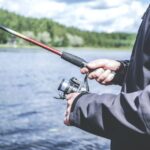How to Catch Bigger Fish in Freshwater: Proven Strategies
Freshwater fishing is a popular pastime for many anglers, and while catching any fish can be a rewarding experience, there’s nothing quite like reeling in a big one. Whether you’re targeting bass, trout, walleye, or any other freshwater species, there are a number of proven strategies you can use to increase your chances of catching bigger fish. In this article, we’ll explore some of the most effective tactics for catching bigger fish in freshwater.
- Choose the Right Equipment
The first step in catching bigger fish is to ensure that you’re using the right equipment. This includes your fishing rod, reel, line, and lures. When it comes to fishing rods, you’ll want to choose one that’s specifically designed for the type of fish you’re targeting. A heavier rod with a stiffer backbone is generally better for larger fish, as it will provide more power to handle their weight and strength.
Your fishing reel should also be appropriate for the size of fish you’re targeting. A larger reel will generally have a higher line capacity and a stronger drag system, which will allow you to handle bigger fish more easily. When it comes to fishing line, a heavier line is generally better for larger fish, as it will be more resistant to breakage.
Finally, you’ll want to choose lures that are appropriate for the size and species of fish you’re targeting. Larger lures, such as swimbaits or spinnerbaits, are generally more effective for bigger fish, as they mimic the size and movement of natural prey.
- Fish During the Right Times
To catch bigger fish, it’s important to fish during the right times of day and year. Many freshwater species, such as bass and walleye, are more active during certain times of day or during specific seasons. For example, early morning and late evening are often the best times to fish for bass, as they tend to be more active during these times. Similarly, walleye are more active during the early spring and fall, when water temperatures are cooler.
In addition to fishing during the right times of day and year, it’s also important to pay attention to the weather. Changes in weather, such as a drop in barometric pressure or an incoming storm, can often trigger fish to become more active and feed more aggressively.
- Use the Right Bait
Choosing the right bait is crucial for catching bigger fish in freshwater. Live bait, such as worms or minnows, can be effective for many species, but artificial lures are often more versatile and can be more effective for targeting larger fish.
When choosing lures, consider the size and species of fish you’re targeting. Larger lures are generally more effective for bigger fish, as they mimic the size and movement of natural prey. Additionally, lures with a natural-looking color and pattern can be more effective for fooling wary fish.
- Focus on Structure and Cover
To catch bigger fish, it’s important to focus your efforts on areas where fish are likely to congregate. This includes areas with structure and cover, such as underwater rock formations, weed beds, or fallen trees.
Many freshwater species, such as bass and trout, will often use structure and cover as a place to hide and ambush prey. By casting your lure near these areas and working it slowly, you can increase your chances of catching bigger fish.
- Vary Your Retrieval Techniques
When fishing for bigger fish, it’s important to vary your retrieval techniques to keep the fish interested and engaged. This can include using a slow and steady retrieve, a jerking or twitching motion, or a stop-and-go retrieve.
Experimenting with different techniques can also help you determine what works best for the fish you’re targeting. For example, some fish may be more responsive to a fast and erratic retrieve, while others may prefer a slow and subtle approach.
- Use Scent Attractants
Using scent attractants can be an effective way to entice bigger fish to strike. These attractants can be applied to your lures or bait to enhance their effectiveness.
There are a number of different scent attractants available, including those that mimic the scent of natural prey or those that are designed to trigger a fish’s predatory instincts. Experimenting with different scents can help you determine what works best for the fish you’re targeting.
Pay Attention to Your Surroundings
To catch bigger fish, it’s important to pay attention to your surroundings and observe the behavior of the fish. This can include watching for signs of feeding activity, such as fish jumping or breaking the surface of the water.
Additionally, paying attention to the behavior of other wildlife, such as birds or insects, can also provide clues as to where fish are likely to be located.
- Be Patient
Finally, it’s important to be patient when fishing for bigger fish. These fish are often more cautious and selective when it comes to feeding, so it may take some time and effort to get them to strike.
By staying patient and persistent, you’ll be more likely to catch the bigger fish you’re targeting.
In conclusion, catching bigger fish in freshwater requires a combination of the right equipment, techniques, and strategies. By choosing the right gear, fishing during the right times, focusing on structure and cover, varying your retrieval techniques, using scent attractants, paying attention to your surroundings, and being patient, you’ll be well on your way to catching bigger and more rewarding fish.






